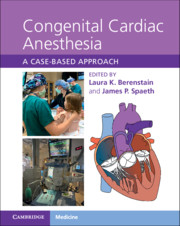Book contents
- Congenital Cardiac Anesthesia
- Congenital Cardiac Anesthesia
- Copyright page
- Dedication
- Contents
- Contributors
- Introduction
- Chapter 1 A Congenital Heart Disease Primer
- Section 1 Left-to-Right Shunts
- Section 2 Right-Sided Obstructive Lesions
- Section 3 Left-Sided Obstructive Lesions
- Chapter 14 Critical Aortic Stenosis
- Chapter 15 Aortic Stenosis
- Chapter 16 Subvalvular Aortic Stenosis
- Chapter 17 Supravalvular Aortic Stenosis
- Chapter 18 Hypertrophic Cardiomyopathy
- Chapter 19 Coarctation of the Aorta
- Chapter 20 Shone Complex
- Section 4 Complex Mixing Lesions
- Section 5 Single-Ventricle Physiology
- Section 6 Heart Failure, Mechanical Circulatory Support, and Transplantation
- Section 7 Miscellaneous Lesions and Syndromes
- Index
- References
Chapter 15 - Aortic Stenosis
from Section 3 - Left-Sided Obstructive Lesions
Published online by Cambridge University Press: 09 September 2021
- Congenital Cardiac Anesthesia
- Congenital Cardiac Anesthesia
- Copyright page
- Dedication
- Contents
- Contributors
- Introduction
- Chapter 1 A Congenital Heart Disease Primer
- Section 1 Left-to-Right Shunts
- Section 2 Right-Sided Obstructive Lesions
- Section 3 Left-Sided Obstructive Lesions
- Chapter 14 Critical Aortic Stenosis
- Chapter 15 Aortic Stenosis
- Chapter 16 Subvalvular Aortic Stenosis
- Chapter 17 Supravalvular Aortic Stenosis
- Chapter 18 Hypertrophic Cardiomyopathy
- Chapter 19 Coarctation of the Aorta
- Chapter 20 Shone Complex
- Section 4 Complex Mixing Lesions
- Section 5 Single-Ventricle Physiology
- Section 6 Heart Failure, Mechanical Circulatory Support, and Transplantation
- Section 7 Miscellaneous Lesions and Syndromes
- Index
- References
Summary
Aortic stenosis occurs in almost 5% of patients with congenital heart disease. Valvular aortic stenosis results from narrowing of the orifice size due to aberrant valve leaflets and is frequently associated with other cardiac lesions. Echocardiography is used to diagnose and quantify the degree of aortic stenosis. Neonates with critical aortic stenosis can present in congestive heart failure requiring urgent intervention, often a percutaneous balloon valvuloplasty. Infants, children, and adults are often asymptomatic, even in the setting of severe aortic stenosis. Surgical interventions for aortic stenosis include aortic valve repair, aortic valve replacement with a pulmonary autograft, or replacement with a mechanical valve. The Ross procedure describes using a pulmonary autograft in the left ventricular outflow tract and pulmonary homograft in the right ventricular outflow tract while the Konno procedure widens a stenotic left ventricular outflow tract. Aortic regurgitation and, less commonly, pulmonary homograft dysfunction can be seen after the Ross procedure.
- Type
- Chapter
- Information
- Congenital Cardiac AnesthesiaA Case-based Approach, pp. 90 - 96Publisher: Cambridge University PressPrint publication year: 2021



